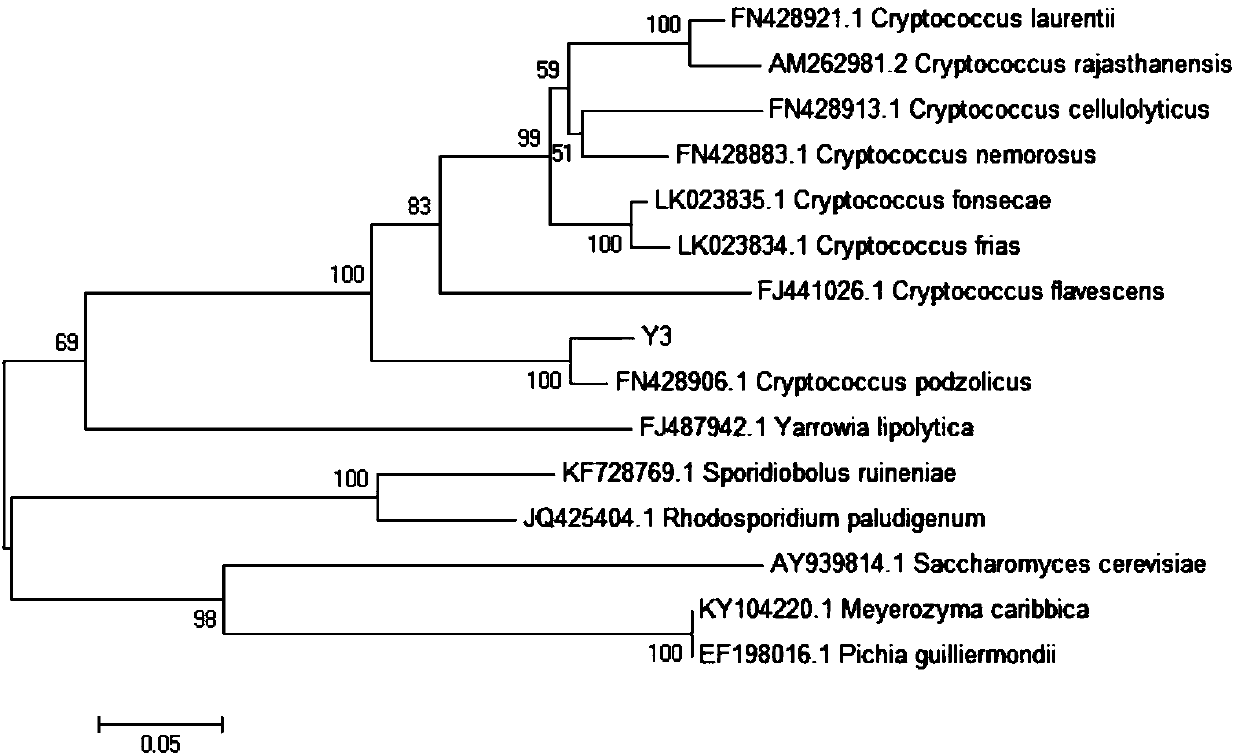Saccharomycetes for degrading citrinin and application
A citrinin and yeast technology, applied in fungi, microorganism-based methods, microorganisms, etc., can solve problems such as low efficiency, affecting food sensory properties, and polluting the environment.
- Summary
- Abstract
- Description
- Claims
- Application Information
AI Technical Summary
Problems solved by technology
Method used
Image
Examples
Embodiment 1
[0023] Embodiment 1: the screening of degrading citrinin yeast, concrete implementation steps are as follows:
[0024] 1. Isolation of yeast single colonies from the environment
[0025] Take 1g of vineyard soil, add it into a centrifuge tube filled with 10mL sterile water, shake and mix well, take the mixed solution, and do gradient dilution (10 -4 , 10 -5 , 10 -6 , 10 -7 ), spread on NYDA medium plate, and culture at 28°C for 20-36h. Pick the dominant yeast single colony and purify and culture it on the NYDA plate. The isolated and purified strains were inoculated on NYDA slant, cultured at 28°C for 48 hours, and stored in a refrigerator at 4°C for short-term storage.
[0026] 2. Determination method of citrinin
[0027] Adopt the method (HPLC-FLD) of high performance liquid phase-fluorescence detector to detect citrinin, the condition is as follows, chromatographic column: Agilent C 18 Column (5.0μm, 150.0mm×4.6mm); mobile phase: acetonitrile: water (0.03% phosphoric...
Embodiment 2
[0035] Example 2: Microbiological properties of Cryptococcus Y3
[0036] The above-mentioned strain Y3 was identified as Cryptococcus podzolicus through morphological culture, physiological and biochemical characteristics tests, and nucleotide sequence analysis of the small subunit 5.8S rDNA and the internal transcribed spacer ITS1 and ITS2 regions.
[0037] Bacterial strain C.podzolicus Y3 bacterial strain (bacterial strain number: CCTCC NO:M2017505) of the present invention has the following microbiological characteristics:
[0038] 1. Morphological features
[0039] (1) On NYDA solid medium plate (beef extract 8g, yeast extract 5g, glucose 10g, agar 20g, distilled water 1000mL; after dispensing into Erlenmeyer flasks, sterilize at 121°C for 20min.) Cultivate at 28°C for 48h, the colonies are eggs Round shape, neat edges, milky white, smooth surface, uniform texture, easy to pick.
[0040] (2) After culturing in NYDB liquid medium for 24 hours, no mold was formed, the bact...
Embodiment 3
[0044] Example 3: Optimization of Citrinin Degradation Conditions by Cryptococcus Y3
[0045] By studying the effect of Cryptococcus Y3 on the degradation of citrinin under the conditions of bacterial concentration, culture temperature, medium pH and different initial concentrations of citrinin, the optimal condition for its degradation of citrinin was determined to be the initial concentration of yeast for 10 8 cells / mL, pH 4, shaker culture temperature 28°C, rotation speed 180rpm, and with the increase of the initial concentration of citrinin, the degradation efficiency is accelerated. When the initial concentration of citrinin was 5 μg / mL, the yeast degradation rate was 77% after 42 hours; when the initial concentration of citrinin was 10 μg / mL, the yeast degradation rate was 96% after 42 hours; When the initial concentration was 20μg / mL, the degradation rate of yeast was 98% after 42h; within 21h-28h, the degradation efficiency was the highest.
[0046] The result shows ...
PUM
 Login to View More
Login to View More Abstract
Description
Claims
Application Information
 Login to View More
Login to View More - R&D Engineer
- R&D Manager
- IP Professional
- Industry Leading Data Capabilities
- Powerful AI technology
- Patent DNA Extraction
Browse by: Latest US Patents, China's latest patents, Technical Efficacy Thesaurus, Application Domain, Technology Topic, Popular Technical Reports.
© 2024 PatSnap. All rights reserved.Legal|Privacy policy|Modern Slavery Act Transparency Statement|Sitemap|About US| Contact US: help@patsnap.com










